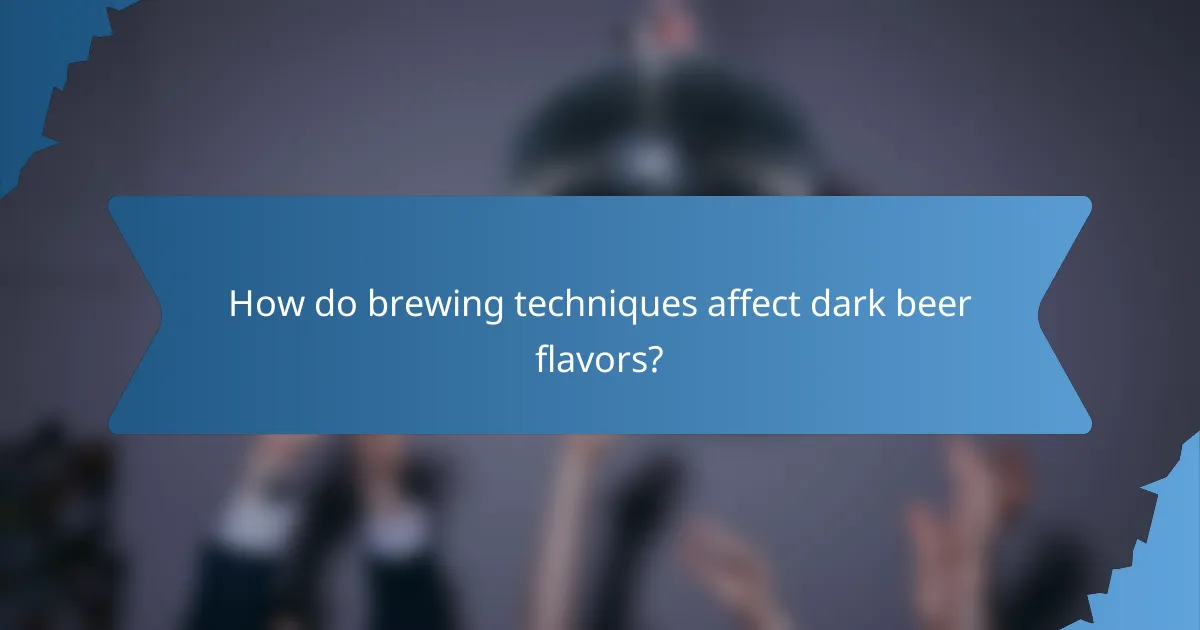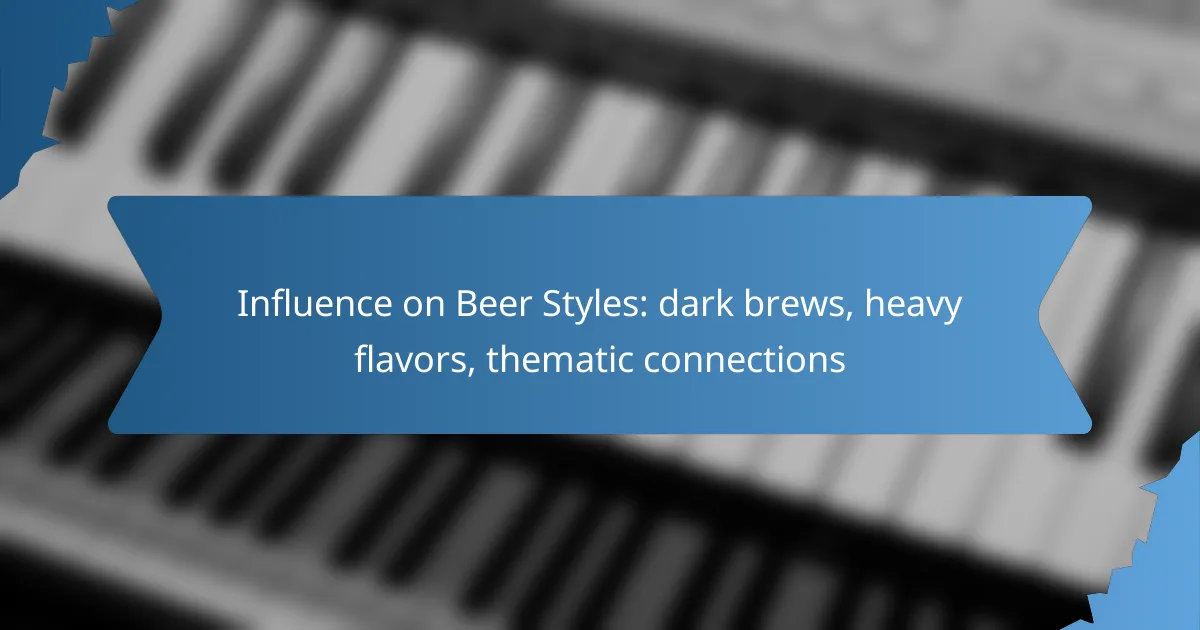Dark brews play a pivotal role in shaping beer styles by introducing rich flavors and innovative brewing techniques that resonate with evolving consumer tastes. Characterized by their intense aromas and full-bodied mouthfeel, these heavy-flavored beers often feature complex notes such as chocolate, coffee, and caramel. Additionally, dark beer styles are intertwined with cultural traditions and seasonal preferences, underscoring their significance in both historical and modern contexts.

How do dark brews influence beer styles in Australia?
Dark brews significantly shape beer styles in Australia by introducing rich flavors and diverse brewing techniques. These influences cater to evolving consumer preferences, leading to a broader appreciation for heavier, more complex beers.
Rich flavor profiles
Dark brews are known for their rich flavor profiles, often featuring notes of chocolate, coffee, and caramel. These flavors arise from the use of roasted malts, which contribute depth and complexity to the beer. As Australian consumers seek more robust tastes, breweries are increasingly experimenting with various dark styles to meet this demand.
For example, a typical Australian porter might showcase a blend of dark chocolate and roasted coffee flavors, appealing to those who enjoy a full-bodied drinking experience. This trend encourages brewers to innovate and refine their recipes, enhancing the overall quality of dark beers available.
Increased popularity of stouts
The popularity of stouts has surged in Australia, driven by a growing interest in dark brews. Many craft breweries are now offering a range of stouts, including milk stouts and imperial stouts, which cater to diverse palates. This increase in availability has made stouts a staple in many pubs and bars across the country.
Seasonal variations, such as chocolate or coffee stouts, further entice consumers and create excitement around dark beers. Events like stout festivals have also emerged, celebrating these rich brews and fostering a community of stout enthusiasts.
Impact on local breweries
Local breweries in Australia are adapting their offerings to include more dark brews, recognizing the demand for unique and flavorful options. This shift has led to increased experimentation with ingredients and brewing techniques, resulting in innovative products that stand out in a competitive market.
Moreover, the focus on dark beers allows breweries to differentiate themselves, attracting customers who are eager to explore new flavors. Collaborations between breweries to create limited-edition dark brews have become common, further enhancing the local craft beer scene and promoting community engagement.

What are the characteristics of heavy-flavored beers?
Heavy-flavored beers are known for their rich, intense tastes and robust aromas, often resulting from high malt content and complex brewing techniques. These beers typically feature a full-bodied mouthfeel and a range of flavors that can include chocolate, coffee, caramel, and various spices.
High malt content
High malt content is a defining characteristic of heavy-flavored beers, contributing to their sweetness and body. Malts are responsible for the sugars that ferment into alcohol, and in these beers, they often include darker varieties like roasted barley or chocolate malt, which enhance flavor depth.
When brewing heavy-flavored beers, aim for a malt bill that comprises at least 40-60% specialty malts. This ratio allows for a balance between sweetness and bitterness, creating a well-rounded beer. Be cautious, as too much malt can lead to an overly sweet profile that masks other flavors.
Complex taste profiles
Complex taste profiles in heavy-flavored beers arise from the combination of various ingredients and brewing methods. These beers often showcase layers of flavors that evolve with each sip, ranging from sweet caramel and dark fruits to bitter chocolate and roasted nuts.
To achieve complexity, consider using a mix of hops, yeast strains, and adjuncts like spices or fruits. For instance, a stout might incorporate coffee and vanilla, while a Belgian dark ale could feature dark fruits and clove. Experimenting with different combinations can yield unique and satisfying results.

Which thematic connections exist in dark beer styles?
Dark beer styles often connect through rich flavors, cultural traditions, and seasonal preferences. These connections highlight the deep-rooted significance of dark brews in various contexts, from historical brewing practices to contemporary consumption trends.
Cultural significance in brewing
Dark beers, such as stouts and porters, have a rich cultural heritage that dates back centuries. Many brewing traditions, especially in Europe, incorporate dark malts, reflecting local agricultural practices and historical events. For instance, the Irish stout is not just a drink but a symbol of national identity and pride.
Additionally, dark beers often feature prominently in festivals and celebrations. Events like Oktoberfest or local beer fests frequently showcase these styles, emphasizing their role in community gatherings and cultural expression.
Seasonal consumption trends
Dark beers typically see increased popularity during the colder months, aligning with seasonal flavors and comfort-seeking behaviors. Many consumers gravitate towards these heavier brews in winter, as they provide warmth and richness that complement hearty meals. This trend is evident in the rise of winter ales and holiday-themed stouts.
Conversely, lighter beer styles often dominate the warmer months, leading to a cyclical pattern in consumer preferences. Breweries may capitalize on this by releasing limited-edition dark beers in fall and winter, catering to seasonal tastes while maintaining interest throughout the year.

What are the best dark beers available in Australia?
Some of the best dark beers in Australia include a range of flavorful options that cater to diverse palates. These brews often feature rich, heavy flavors that highlight the unique characteristics of dark malts, making them a favorite among beer enthusiasts.
Coopers Dark Ale
Coopers Dark Ale is a classic Australian dark beer known for its smooth, rich flavor profile. It typically features notes of chocolate and coffee, balanced by a slight bitterness, making it a great choice for those who enjoy a robust brew.
This ale is unfiltered and bottle-conditioned, which adds to its complexity and depth. It pairs well with hearty dishes like beef stew or rich desserts, enhancing the overall dining experience.
Little Creatures Rogers’ Beer
Little Creatures Rogers’ Beer is a unique offering that blends dark malt flavors with a lighter body, making it an accessible choice for those new to dark beers. This amber ale has a mild sweetness complemented by hints of caramel and toffee.
Its lower alcohol content allows for easy drinking, making it suitable for casual gatherings. It pairs nicely with grilled meats and spicy dishes, providing a refreshing contrast to bold flavors.
James Squire 150 Lashes
James Squire 150 Lashes is a well-balanced pale ale that incorporates dark malt characteristics without overwhelming bitterness. This beer features a blend of fruity and malty flavors, creating a harmonious taste experience.
It is a versatile option that works well with a variety of foods, from pizza to barbecue. Its approachable flavor profile makes it a popular choice among both craft beer aficionados and casual drinkers alike.

How do brewing techniques affect dark beer flavors?
Brewing techniques significantly influence the flavors of dark beers, primarily through the selection of ingredients and the methods used during production. Key factors include the use of roasted malts and fermentation processes, which together create the rich, complex flavors characteristic of dark brews.
Use of roasted malts
Roasted malts are essential for developing the deep colors and flavors in dark beers. These malts are typically kilned at high temperatures, resulting in a range of flavors from chocolate to coffee. The degree of roasting can vary, with lighter roasts contributing subtle sweetness and darker roasts adding bitterness and astringency.
When selecting roasted malts, brewers often combine different types to achieve a balanced flavor profile. For example, a blend of chocolate malt and black malt can create a rich, layered taste. It’s crucial to monitor the proportion of roasted malts, as too much can overpower the beer’s overall character.
Fermentation processes
Fermentation processes also play a vital role in shaping the flavors of dark beers. The choice of yeast and fermentation temperature can greatly affect the final taste. For instance, warmer fermentation temperatures can enhance fruity esters, while cooler temperatures might emphasize the malt profile.
Additionally, the duration of fermentation can influence the beer’s complexity. Extended fermentation times may lead to a smoother finish, allowing flavors to meld. Brewers should be cautious, however, as overly long fermentation can strip away some of the desired characteristics of dark beers.

What role do ingredients play in dark beer styles?
Ingredients are crucial in defining dark beer styles, influencing their flavor, aroma, and overall character. Key components like malts, hops, and water chemistry work together to create the rich, complex profiles typical of dark brews.
Hops varieties
Hops varieties significantly affect the bitterness and aroma of dark beers. While dark beers often emphasize malt flavors, the choice of hops can introduce floral, citrus, or earthy notes that complement the heavy flavors. Common hops used in dark brews include Fuggle, East Kent Goldings, and Cascade, which can enhance the beer’s overall balance.
When selecting hops for dark beers, consider the timing of the addition during the brewing process. Late additions or dry hopping can accentuate hop aromas without overwhelming the malt character, maintaining the intended flavor profile.
Water chemistry
Water chemistry plays a vital role in brewing dark beers, as the mineral content can influence the taste and mouthfeel. Dark beers typically benefit from higher levels of certain minerals, such as sulfate and chloride, which can enhance the perception of bitterness and fullness, respectively.
Brewers should analyze their water profile and adjust it to suit the dark beer style they are crafting. For instance, a higher sulfate-to-chloride ratio can accentuate hop bitterness, while a more balanced ratio can promote a smoother, malt-forward experience. Regular testing and adjustments can help achieve the desired flavor outcomes.

How do consumer preferences shape dark beer offerings?
Consumer preferences significantly influence the variety and characteristics of dark beer offerings. As tastes evolve, breweries adapt their recipes and marketing strategies to meet the demand for richer flavors and unique styles.
Trends in craft brewing
Craft brewing has seen a surge in popularity for dark beers, particularly stouts and porters, as consumers seek bold flavors and innovative ingredients. Many breweries experiment with adjuncts like coffee, chocolate, and spices to create distinctive profiles that appeal to adventurous drinkers.
Seasonal trends also play a role; for example, darker beers often see increased sales during colder months. Breweries may release limited-edition brews or collaborations that highlight these seasonal preferences, further shaping the market.
Influence of social media
Social media platforms have transformed how consumers discover and engage with dark beers. Breweries leverage these platforms to showcase new releases, share brewing processes, and connect with their audience, creating a community around dark beer appreciation.
User-generated content, such as reviews and photos, can significantly impact consumer choices. Positive feedback and visually appealing posts can drive interest and sales, prompting breweries to focus on marketing their dark beer offerings more effectively.

What are the emerging trends in dark beer consumption?
Emerging trends in dark beer consumption indicate a growing interest in rich, complex flavors and innovative brewing techniques. Consumers are increasingly seeking out unique dark brews that offer heavy flavors and thematic connections to culture and history.
Increased Popularity of Craft Dark Beers
The craft beer movement has significantly boosted the popularity of dark beers, with many breweries experimenting with various styles such as stouts, porters, and black IPAs. This trend reflects a broader consumer desire for artisanal products that emphasize quality and creativity.
Many craft breweries are now offering seasonal dark beers that incorporate local ingredients or unique flavor profiles, appealing to adventurous drinkers. For example, a chocolate stout brewed with locally sourced cocoa can attract consumers looking for a distinctive experience.
Health-Conscious Choices
As health awareness rises, some consumers are gravitating towards dark beers perceived as healthier options due to their higher antioxidant content. Dark beers often contain roasted malts, which can provide certain health benefits when consumed in moderation.
Breweries are responding by developing lower-calorie dark beer options or those with reduced alcohol content, making them more appealing to health-conscious drinkers. This shift allows consumers to enjoy the rich flavors of dark beers while maintaining their dietary preferences.
Flavor Experimentation and Innovation
Flavor experimentation is a key trend in dark beer production, with brewers incorporating unconventional ingredients such as spices, fruits, and even coffee. This innovation leads to unique flavor profiles that can surprise and delight consumers.
For instance, a coffee-infused porter or a chili stout can create a memorable tasting experience, encouraging consumers to explore beyond traditional dark beer offerings. This trend not only enhances the drinking experience but also fosters a deeper connection to the craft of brewing.
Thematic Connections and Storytelling
Dark beers are increasingly tied to thematic storytelling, where breweries highlight the cultural or historical significance of their brews. This approach resonates with consumers who appreciate the narrative behind their beverages.
Breweries often share the inspiration behind a particular dark beer, such as a recipe rooted in local history or a brew that celebrates a specific event. This storytelling aspect can enhance consumer engagement and loyalty, as drinkers feel a connection to the product beyond just taste.
